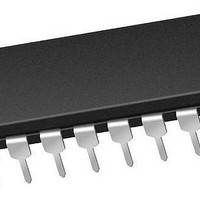PIC16F1829-E/P Microchip Technology, PIC16F1829-E/P Datasheet - Page 282

PIC16F1829-E/P
Manufacturer Part Number
PIC16F1829-E/P
Description
14 KB Flash, 1K Bytes RAM, 32 MHz Int. Osc, 18 I/0, Enhanced Mid Range Core 20 P
Manufacturer
Microchip Technology
Series
PIC® XLP™ mTouch™ 16Fr
Datasheet
1.PIC16LF1829-ISO.pdf
(420 pages)
Specifications of PIC16F1829-E/P
Core Processor
PIC
Core Size
8-Bit
Speed
32MHz
Connectivity
I²C, LIN, SPI, UART/USART
Peripherals
Brown-out Detect/Reset, POR, PWM, WDT
Number Of I /o
17
Program Memory Size
14KB (8K x 14)
Program Memory Type
FLASH
Eeprom Size
256 x 8
Ram Size
1K x 8
Voltage - Supply (vcc/vdd)
1.8 V ~ 5.5 V
Data Converters
A/D 12x10b
Oscillator Type
Internal
Operating Temperature
-40°C ~ 125°C
Package / Case
*
Processor Series
PIC16F182x
Core
PIC
Data Bus Width
8 bit
Data Ram Size
1 KB
Interface Type
I2C, SPI, USART
Maximum Clock Frequency
32 MHz
Number Of Programmable I/os
18
Number Of Timers
5
Operating Supply Voltage
1.8 V to 5.5 V
Maximum Operating Temperature
+ 125 C
Mounting Style
Through Hole
Lead Free Status / RoHS Status
Lead free / RoHS Compliant
Lead Free Status / RoHS Status
Lead free / RoHS Compliant
- Current page: 282 of 420
- Download datasheet (5Mb)
PIC16F/LF1825/1829
25.6.8
An Acknowledge sequence is enabled by setting the
Acknowledge Sequence Enable bit, ACKEN bit of the
SSPxCON2 register. When this bit is set, the SCLx pin is
pulled low and the contents of the Acknowledge data bit
are presented on the SDAx pin. If the user wishes to
generate an Acknowledge, then the ACKDT bit should
be cleared. If not, the user should set the ACKDT bit
before starting an Acknowledge sequence. The Baud
Rate Generator then counts for one rollover period
(T
When the SCLx pin is sampled high (clock arbitration),
the Baud Rate Generator counts for T
is then pulled low. Following this, the ACKEN bit is auto-
matically cleared, the Baud Rate Generator is turned off
and the MSSPx module then goes into Idle mode
(Figure
25.6.8.1
If the user writes the SSPxBUF when an Acknowledge
sequence is in progress, then the WCOL bit is set and
the contents of the buffer are unchanged (the write
does not occur).
FIGURE 25-30:
DS41440A-page 284
BRG
) and the SCLx pin is deasserted (pulled high).
25-29).
Note: T
ACKNOWLEDGE SEQUENCE
TIMING
WCOL Status Flag
SSPxIF
BRG
SDAx
SCLx
Acknowledge sequence starts here,
= one Baud Rate Generator period.
ACKNOWLEDGE SEQUENCE WAVEFORM
SSPxIF set at
the end of receive
ACKEN = 1, ACKDT = 0
write to SSPxCON2
BRG
. The SCLx pin
8
D0
Preliminary
Cleared in
software
T
BRG
ACK
25.6.9
A Stop bit is asserted on the SDAx pin at the end of a
receive/transmit by setting the Stop Sequence Enable
bit, PEN bit of the SSPxCON2 register. At the end of a
receive/transmit, the SCLx line is held low after the
falling edge of the ninth clock. When the PEN bit is set,
the master will assert the SDAx line low. When the
SDAx line is sampled low, the Baud Rate Generator is
reloaded and counts down to ‘0’. When the Baud Rate
Generator times out, the SCLx pin will be brought high
and one T
later, the SDAx pin will be deasserted. When the SDAx
pin is sampled high while SCLx is high, the P bit of the
SSPxSTAT register is set. A T
cleared and the SSPxIF bit is set
25.6.9.1
If the user writes the SSPxBUF when a Stop sequence
is in progress, then the WCOL bit is set and the
contents of the buffer are unchanged (the write does
not occur).
T
BRG
9
SSPxIF set at the end
of Acknowledge sequence
BRG
STOP CONDITION TIMING
WCOL Status Flag
ACKEN automatically cleared
(Baud Rate Generator rollover count)
2010 Microchip Technology Inc.
Cleared in
software
BRG
(Figure
later, the PEN bit is
25-30).
Related parts for PIC16F1829-E/P
Image
Part Number
Description
Manufacturer
Datasheet
Request
R

Part Number:
Description:
IC, 8BIT MCU, PIC16F, 32MHZ, SOIC-18
Manufacturer:
Microchip Technology
Datasheet:

Part Number:
Description:
IC, 8BIT MCU, PIC16F, 32MHZ, SSOP-20
Manufacturer:
Microchip Technology
Datasheet:

Part Number:
Description:
IC, 8BIT MCU, PIC16F, 32MHZ, DIP-18
Manufacturer:
Microchip Technology
Datasheet:

Part Number:
Description:
IC, 8BIT MCU, PIC16F, 32MHZ, QFN-28
Manufacturer:
Microchip Technology
Datasheet:

Part Number:
Description:
IC, 8BIT MCU, PIC16F, 32MHZ, QFN-28
Manufacturer:
Microchip Technology
Datasheet:

Part Number:
Description:
IC, 8BIT MCU, PIC16F, 32MHZ, QFN-28
Manufacturer:
Microchip Technology
Datasheet:

Part Number:
Description:
IC, 8BIT MCU, PIC16F, 32MHZ, SSOP-20
Manufacturer:
Microchip Technology
Datasheet:

Part Number:
Description:
IC, 8BIT MCU, PIC16F, 20MHZ, DIP-40
Manufacturer:
Microchip Technology
Datasheet:

Part Number:
Description:
IC, 8BIT MCU, PIC16F, 32MHZ, QFN-28
Manufacturer:
Microchip Technology
Datasheet:

Part Number:
Description:
IC, 8BIT MCU, PIC16F, 20MHZ, MQFP-44
Manufacturer:
Microchip Technology
Datasheet:

Part Number:
Description:
IC, 8BIT MCU, PIC16F, 20MHZ, QFN-20
Manufacturer:
Microchip Technology
Datasheet:

Part Number:
Description:
IC, 8BIT MCU, PIC16F, 32MHZ, QFN-28
Manufacturer:
Microchip Technology
Datasheet:

Part Number:
Description:
MCU 14KB FLASH 768B RAM 64-TQFP
Manufacturer:
Microchip Technology
Datasheet:

Part Number:
Description:
7 KB Flash, 384 Bytes RAM, 32 MHz Int. Osc, 16 I/0, Enhanced Mid Range Core, Low
Manufacturer:
Microchip Technology

Part Number:
Description:
14KB Flash, 512B RAM, 256B EEPROM, LCD, 1.8-5.5V 40 UQFN 5x5x0.5mm TUBE
Manufacturer:
Microchip Technology
Datasheet:










